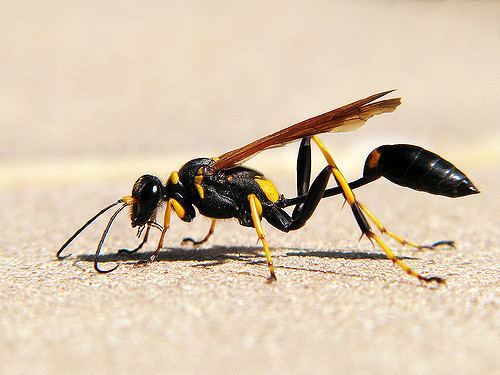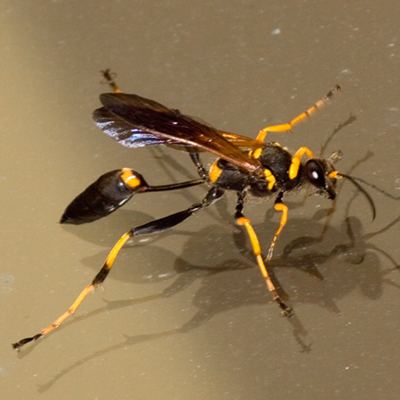Scientific name Sceliphron caementarium Rank Species | ||
 | ||
Similar Sceliphron, Insect, Sphecidae, Blue mud dauber, Hymenopterans | ||
Black and yellow mud dauber sting
Black and yellow mud dauber is a common name for the sphecid wasp species Sceliphron caementarium.
Contents
- Black and yellow mud dauber sting
- Mud insect nest black and yellow mud dauber mud wasp
- Etymology
- Distribution
- Habitat
- Description
- Biology
- Mentions in Popular Media
- References
There are some 30 other species of Sceliphron that occur throughout the world, though in appearance and habits they are quite similar to S. caementarium.

Mud insect nest black and yellow mud dauber mud wasp
Etymology
The Latin species name caementarius means mason or builder of walls.
Distribution
S. caementarium is widespread in Canada, the United States, Central America, South Africa and the West Indies, and has been introduced to many Pacific Islands (including Australia, Hawaii and Japan), Peru and Europe, where it has become established in some countries of the western Mediterranean Basin (Austria, Croatia, France, Italy, Cyprus, Ukraine).
Habitat
This species may be found in cypress domes, in long leaf pines (Pinus palustris) and in turkey oaks.
Description

Sceliphron caementarium can reach a length of 24–28 millimetres (0.94–1.10 in). petiole is black, about half the length of the entire abdomen. The thorax shows various yellow markings, while the abdomen is normally black, with yellow propodeum (typical of females). The eyes are black, the antennae are black and the legs are yellow, with black trochanters and femurs. The wings are a tawny color.
Biology
The black and yellow mud dauber's are solitary insects that build nests out of mud.

These sphecid wasps collect mud balls at puddle and pool edges for constructing nests. Nests are built in sheltered locations, frequently on man-made structure such as bridges, barns, open porches or under the eaves of houses. These nests comprise up to 25 cylindrical cells arranged vertically. Then usually this sphecid wasp covers with more mud the whole cluster of cells, forming a smooth nest that may attain nearly the size of a human fist.

After building a cell of the nest, the female wasp captures several spiders. The captured prey are stung and paralyzed before being placed in the nest (usually 6-15 per cell), and then a single egg is deposited on the prey within each cell. The wasp then seals the cell with a thick mud plug. After finishing a series of cells, she leaves and does not return. The larva spins a cocoon and pupates. Eventually, the hatching larva will eat the prey and emerge from the nest.
Adults can be seen in mid-summer feeding on nectar at flowers, especially Queen Anne's lace, parsnip and water parsnip (Sium suave, Sium latifolium, Berula erecta). They have a low reproductive rate. Stings are rare due to their usually peaceful nature, however nests are aggressively defended.
A common species of cuckoo wasp, Chrysis angolensis, is frequently a cleptoparasite in Sceliphron nests, and is only one of many different insects that parasitize these mud daubers.
Mentions in Popular Media
In 1996, Birgenair Flight 301 crashed near Puerto Rico. The most probable cause of this Boeing 757 crash was a blockade in a Pitot tube (device for air speed measurement) by a mud dauber's nest.
